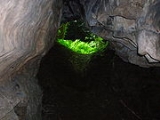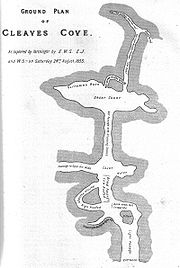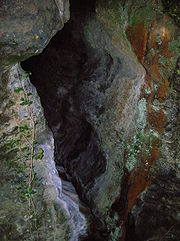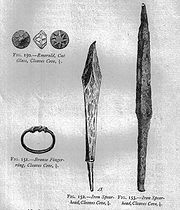
Cleeves Cove cave
Encyclopedia
Cleeves Cove is a cave system on the Dusk Water in North Ayrshire
, Scotland
, close to the town of Dalry
.
. It measures around 500 feet if all the passages were put together. The caves are now well above the level of the Dusk Water
and lie close to Cleeves Farm and Blair Mill on the Blair Estate. Many of the stalactite
s and stalagmite
s have been damaged by visitors. The cave has three practical entrances facing onto the Dusk Water.
A number of older books refer to the romantic sylvan dell of Auchenskeigh, now Auchenskeith, derived from Achadh-na-sgitheach - the field of thorns. The calcareous incrustations in these caves were compared with Gothic
fretwork. A number of old limestone quarries lie close to the modern day farm of Auchenskeith, but it is likely that Auchenskeigh is a synonym for Cleeves Cove.
means 'Cave'. John Smith published a monograph entitled Cleaves Cove Stalactites and Stalagmites, published by Mr. Elliot Stock in which he provided drawings and a detailed description of these structures within the cave system, many of which have been destroyed. The site was previously known as the 'Elfhouse' or 'Elfhame' the locals at that time believed that these magical creatures had made this their abode. Ness calls the site 'Glen O'Dusk' or the Elf-hame, the caves being the Elf-house.

 The cave system was created in the Dusk Glen when the waters of the Dusk (Gaelic for 'black water') ran through and eroded the limestone
The cave system was created in the Dusk Glen when the waters of the Dusk (Gaelic for 'black water') ran through and eroded the limestone
, followed by a period when it was relatively dry allowing the stalactites and stalagmites to form and finally a progressive infilling with soil washed in from above, resulting in a partial infilling of the caves and passageways; at this point John Smith obtained permission from Captain Blair, R.N., of Blair House to explore and ultimately remove some 300 tons of material. The cave now lies 40 feet above the Dusk Water due to the excavation of the gorge by the river. Near the middle is a spacious chamber, 35 feet long by 27 broad and 12 high. The internal surfaces of the chambers and passageways are covered with calcareous incrustations and numerous crevices branch off in all directions. It was regarded in Victorian times as one of the greatest natural curiosities in Ayrshire.
 The fictional Dr.Duguid refers to "Smith's Room" in the caves although he did not know if Smith was a hermit, smuggler or covenanter. The name is a coincidence as the recollections are before John Smith's time.
The fictional Dr.Duguid refers to "Smith's Room" in the caves although he did not know if Smith was a hermit, smuggler or covenanter. The name is a coincidence as the recollections are before John Smith's time.
During his excavations John Smith unearthed a number of man-made objects such as a flint knife, spindle-whorl, bone spoon, bronze finger-rings, bone spoon, a stag's horn handle, spear heads, parts of a bridle, an iron battle-axe and a cut-glass emerald. Various bones were found, including those of beaver, sheep, hare, rabbit, cat, rat, dog, weasel, pheasant, partridge, duck, goat, ox, pig and goose. The seeds of fourteen species of plants were found; however, none were from edible cereals.
s during the times of their persecution by the government of Charles II
(1630–85) and Paterson confirms this, indicating that the Statistical Account of Ayrshire, written by the local ministers, was his source. Cummell records that the Covenanters held Conventicles in the glen.
The cave system has unsurprisingly been the haunt of foxes, bats and other animals.
s were acorn cups and they drank wine beneath the toadstools. Their cloths were green velvet and their arrows were made of moss-reed tipped with flint arrow heads that were dipped in hemlock poison. The bows were made from the rib bones of unbaptised babies who had been secretly buried in the shaw
s and glens.
is located at Pondery Hill in the nearby Pencot and Bowertrapping Community Woodland. A GPS will be required to locate it.
North Ayrshire
North Ayrshire is one of 32 council areas in Scotland with a population of roughly 136,000 people. It is located in the south-west region of Scotland, and borders the areas of Inverclyde to the north, Renfrewshire to the north-east and East Ayrshire and South Ayrshire to the East and South...
, Scotland
Scotland
Scotland is a country that is part of the United Kingdom. Occupying the northern third of the island of Great Britain, it shares a border with England to the south and is bounded by the North Sea to the east, the Atlantic Ocean to the north and west, and the North Channel and Irish Sea to the...
, close to the town of Dalry
Dalry, North Ayrshire
Dalry is a small town in the Garnock Valley in Ayrshire, Scotland.-History:Dalry means "King's Valley" or more simply the "Rye Meadow"; indicating a small settlement on the Rye Burn. Its history has signs of early inhabitants in the area...
.
The cave system
Cleeves, or Cleaves, cove cave system is situated in the lower bed of carboniferous limestoneLimestone
Limestone is a sedimentary rock composed largely of the minerals calcite and aragonite, which are different crystal forms of calcium carbonate . Many limestones are composed from skeletal fragments of marine organisms such as coral or foraminifera....
. It measures around 500 feet if all the passages were put together. The caves are now well above the level of the Dusk Water
River Garnock
The River Garnock, the smallest of Ayrshire's six principal rivers, has its source on the southerly side of the Hill of Stake in the heart of the Clyde Muirshiel Regional Park. About a mile and a half south of this starting point the untested stream tumbles over the Spout of Garnock, the highest...
and lie close to Cleeves Farm and Blair Mill on the Blair Estate. Many of the stalactite
Stalactite
A stalactite , "to drip", and meaning "that which drips") is a type of speleothem that hangs from the ceiling of limestone caves. It is a type of dripstone...
s and stalagmite
Stalagmite
A stalagmite is a type of speleothem that rises from the floor of a limestone cave due to the dripping of mineralized solutions and the deposition of calcium carbonate. This stalagmite formation occurs only under certain pH conditions within the underground cavern. The corresponding formation on...
s have been damaged by visitors. The cave has three practical entrances facing onto the Dusk Water.
A number of older books refer to the romantic sylvan dell of Auchenskeigh, now Auchenskeith, derived from Achadh-na-sgitheach - the field of thorns. The calcareous incrustations in these caves were compared with Gothic
Gothic art
Gothic art was a Medieval art movement that developed in France out of Romanesque art in the mid-12th century, led by the concurrent development of Gothic architecture. It spread to all of Western Europe, but took over art more completely north of the Alps, never quite effacing more classical...
fretwork. A number of old limestone quarries lie close to the modern day farm of Auchenskeith, but it is likely that Auchenskeigh is a synonym for Cleeves Cove.
History
The word 'Cove' in ScotsScots language
Scots is the Germanic language variety spoken in Lowland Scotland and parts of Ulster . It is sometimes called Lowland Scots to distinguish it from Scottish Gaelic, the Celtic language variety spoken in most of the western Highlands and in the Hebrides.Since there are no universally accepted...
means 'Cave'. John Smith published a monograph entitled Cleaves Cove Stalactites and Stalagmites, published by Mr. Elliot Stock in which he provided drawings and a detailed description of these structures within the cave system, many of which have been destroyed. The site was previously known as the 'Elfhouse' or 'Elfhame' the locals at that time believed that these magical creatures had made this their abode. Ness calls the site 'Glen O'Dusk' or the Elf-hame, the caves being the Elf-house.


Limestone
Limestone is a sedimentary rock composed largely of the minerals calcite and aragonite, which are different crystal forms of calcium carbonate . Many limestones are composed from skeletal fragments of marine organisms such as coral or foraminifera....
, followed by a period when it was relatively dry allowing the stalactites and stalagmites to form and finally a progressive infilling with soil washed in from above, resulting in a partial infilling of the caves and passageways; at this point John Smith obtained permission from Captain Blair, R.N., of Blair House to explore and ultimately remove some 300 tons of material. The cave now lies 40 feet above the Dusk Water due to the excavation of the gorge by the river. Near the middle is a spacious chamber, 35 feet long by 27 broad and 12 high. The internal surfaces of the chambers and passageways are covered with calcareous incrustations and numerous crevices branch off in all directions. It was regarded in Victorian times as one of the greatest natural curiosities in Ayrshire.

Excavations
Smith started in January 1883, working at night, with six volunteers, removing and sifting through 300 tons of deposits over a period of six months. He organised a trip on the Clyde as a reward to his helpers. He recorded his work in several journals and books, producing a map and giving names to some of the features and entrances.During his excavations John Smith unearthed a number of man-made objects such as a flint knife, spindle-whorl, bone spoon, bronze finger-rings, bone spoon, a stag's horn handle, spear heads, parts of a bridle, an iron battle-axe and a cut-glass emerald. Various bones were found, including those of beaver, sheep, hare, rabbit, cat, rat, dog, weasel, pheasant, partridge, duck, goat, ox, pig and goose. The seeds of fourteen species of plants were found; however, none were from edible cereals.
Human and animal occupants
Charcoal deposits were found, suggesting that fires had been lit within. The evidence suggests that the caves were used at some point by humans for either temporary shelter, refuge at times of crisis or both. Dobie records that the cave system was used as a refuge for the local CovenanterCovenanter
The Covenanters were a Scottish Presbyterian movement that played an important part in the history of Scotland, and to a lesser extent in that of England and Ireland, during the 17th century...
s during the times of their persecution by the government of Charles II
Charles II of England
Charles II was monarch of the three kingdoms of England, Scotland, and Ireland.Charles II's father, King Charles I, was executed at Whitehall on 30 January 1649, at the climax of the English Civil War...
(1630–85) and Paterson confirms this, indicating that the Statistical Account of Ayrshire, written by the local ministers, was his source. Cummell records that the Covenanters held Conventicles in the glen.
The cave system has unsurprisingly been the haunt of foxes, bats and other animals.
Elfhame
Robin Cummell records that the caves were the Elfhame and that at Halloween they would come riding out of the caves on horses that were the size of mice, their long yellow hair straming or tied in knots with crimps of gold. Their quaichQuaich
A quaich , archaically quaigh, is a special kind of shallow two-handled drinking cup or bowl in Scotland. It derives from the Scottish Gaelic cuach meaning a cup....
s were acorn cups and they drank wine beneath the toadstools. Their cloths were green velvet and their arrows were made of moss-reed tipped with flint arrow heads that were dipped in hemlock poison. The bows were made from the rib bones of unbaptised babies who had been secretly buried in the shaw
Shaw (woodland)
A shaw is a strip of woodland usually between 5 and 15 metres wide.Shaws commonly form boundaries between fields or line a road. They are usually composed of natural woodland and often have diverse woodland ground vegetation similar to other natural woodlands in the area...
s and glens.
The Pondery Geocache
A GeocacheGeocaching
Geocaching is an outdoor sporting activity in which the participants use a Global Positioning System receiver or mobile device and other navigational techniques to hide and seek containers, called "geocaches" or "caches", anywhere in the world....
is located at Pondery Hill in the nearby Pencot and Bowertrapping Community Woodland. A GPS will be required to locate it.

